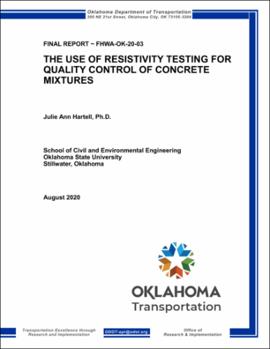| dc.creator | Hartell, Julie Ann | en_US |
| dc.date.accessioned | 2021-09-28T18:51:32Z | |
| dc.date.available | 2021-09-28T18:51:32Z | |
| dc.date.issued | 2020-08 | |
| dc.identifier.govdoc | FHWA-OK-20-03 | en_US |
| dc.identifier.other | Oklahoma Department of Transportation State Planning and Research item number 2266 | en_US |
| dc.identifier.uri | https://hdl.handle.net/11244/330987 | |
| dc.description.abstract | This study proposes a new quality control and compliance method for concrete mixture design using standard
surface resistivity testing. This method helps in determining key mixture parameters such as fly ash content
and w/cm of placed concrete. Based on the gain in resistivity over time, it was found that the slope of the
surface resistivity versus time curve could be used to differentiate fly ash content. And, the resistivity value
obtained at a sample age of 14 and 28 days could be used for identifying the water-to-cementitious material
ratio of a concrete mixture containing no fly ash and containing up to 20% fly ash. Several other parameters
such as, aggregate type and admixture addition are also evaluated for their effect on the outcome of a
resistivity test. The proposed resistivity method could be used as a means for quality acceptance of mixture
design during the construction stage. Three methodologies (Procedure A, B and C) for OkDOT Classes A and
AA concrete mixtures are developed and trialed as part of a field study. In addition, the influence of laboratory
ambient temperature and curing temperature was also investigated. It was found that if resistivity testing is
performed in a standard temperature-controlled environment, resistivity variances are negligible. Finally, with
all quality control material testing, an alternative test method is investigated in the event the primary lab
specimen fails to meet the specification. The secondary compliance testing method targets the adequacy of
concrete constructed onsite. In the end, the outcomes of the project can aid a DOT in devising a strategy for
implementation of the resistivity method. The new tool enables control of placed concrete with respect to the
approved mixture design. | en_US |
| dc.format.extent | 172 pages | en_US |
| dc.format.extent | 2,589,277 bytes | en_US |
| dc.format.medium | application.pdf | en_US |
| dc.language | en_US | en_US |
| dc.relation.ispartofseries | No | en_US |
| dc.relation.requires | Adobe Acrobat Reader | en_US |
| dc.title | THE USE OF RESISTIVITY TESTING FOR QUALITY CONTROL OF CONCRETE MIXTURES (FHWA-OK-20-03) | en_US |
| dc.type | Technical Report | en_US |
| dc.description.version | Final Report October 2014 - January 2020 | en_US |
| dc.description.peerreview | No | en_US |
| dc.type.material | text | en_US |
| dc.subject.keywords | Concrete | en_US |
| dc.subject.keywords | Resistivity | en_US |
| dc.subject.keywords | Quality Control | en_US |
| dc.subject.keywords | Quality Acceptance | en_US |
| dc.contributor.sponsor | Oklahoma Department of Transportation. Materials and Research Division. Office of Research & Implementation | en_US |
